IT Ethics Video 2: Development Methodology Ethical Dilemma Analysis
VerifiedAdded on 2023/04/11
|8
|1153
|211
Report
AI Summary
This report analyzes an IT ethics video titled 'Development Methodology,' which presents an ethical dilemma faced by an ICT professional. The scenario involves a junior developer who agrees to client changes without consulting the project manager, leading to a violation of position hierarchy and potential ethical breaches. The report examines the situation through the lens of the Australian Computer Society (ACS) Code of Ethics, focusing on principles such as the primacy of public interest, honesty, competence, and professionalism. The analysis identifies specific ethical violations and assesses three potential video endings, recommending the option where the project manager instructs the developer to follow the proper hierarchy. This recommendation aligns with the ACS code of ethics, emphasizing honest communication, prioritizing public interest, and promoting professional conduct to resolve the ethical dilemma.
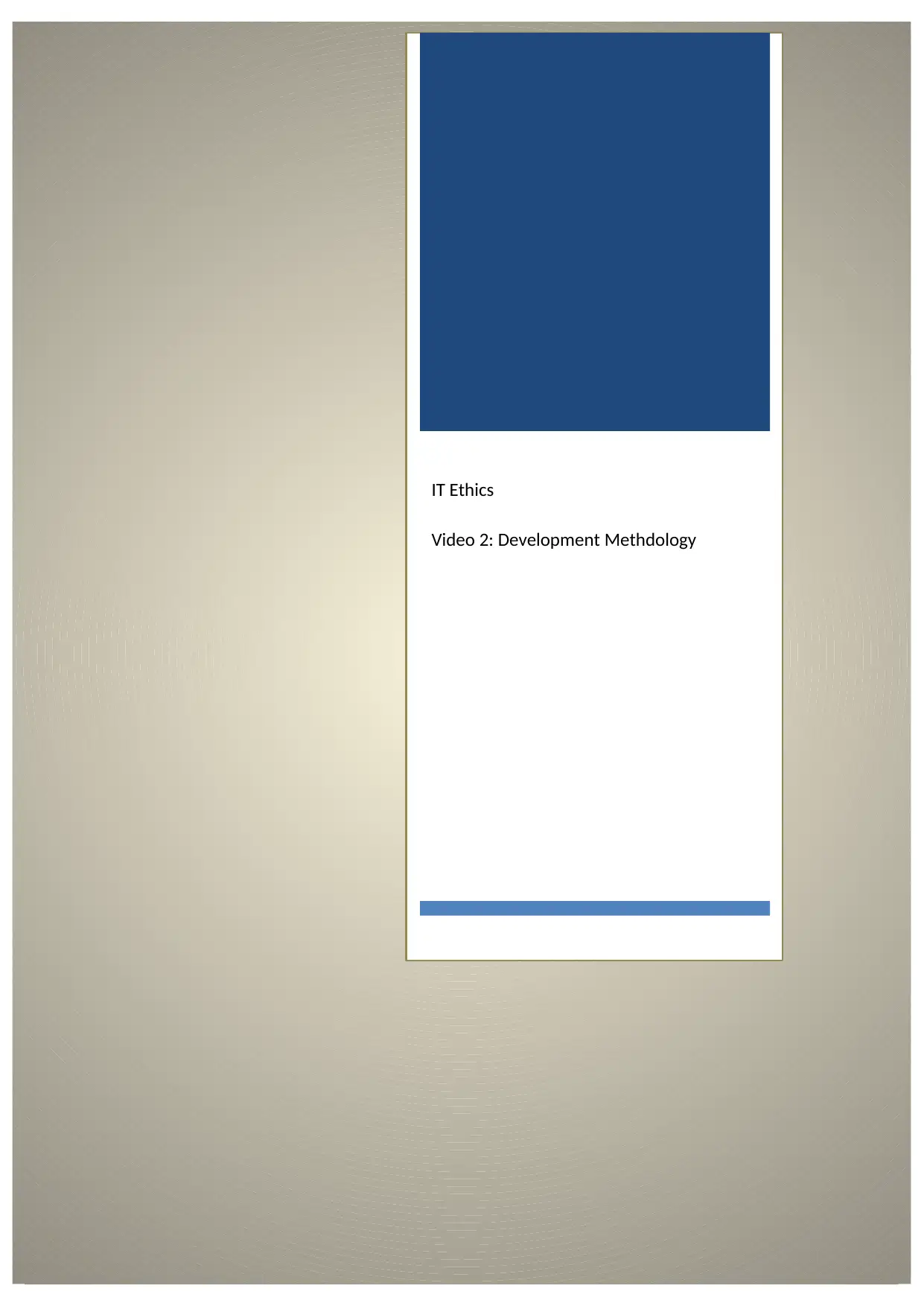
IT Ethics
Video 2: Development Methdology
Video 2: Development Methdology
Paraphrase This Document
Need a fresh take? Get an instant paraphrase of this document with our AI Paraphraser
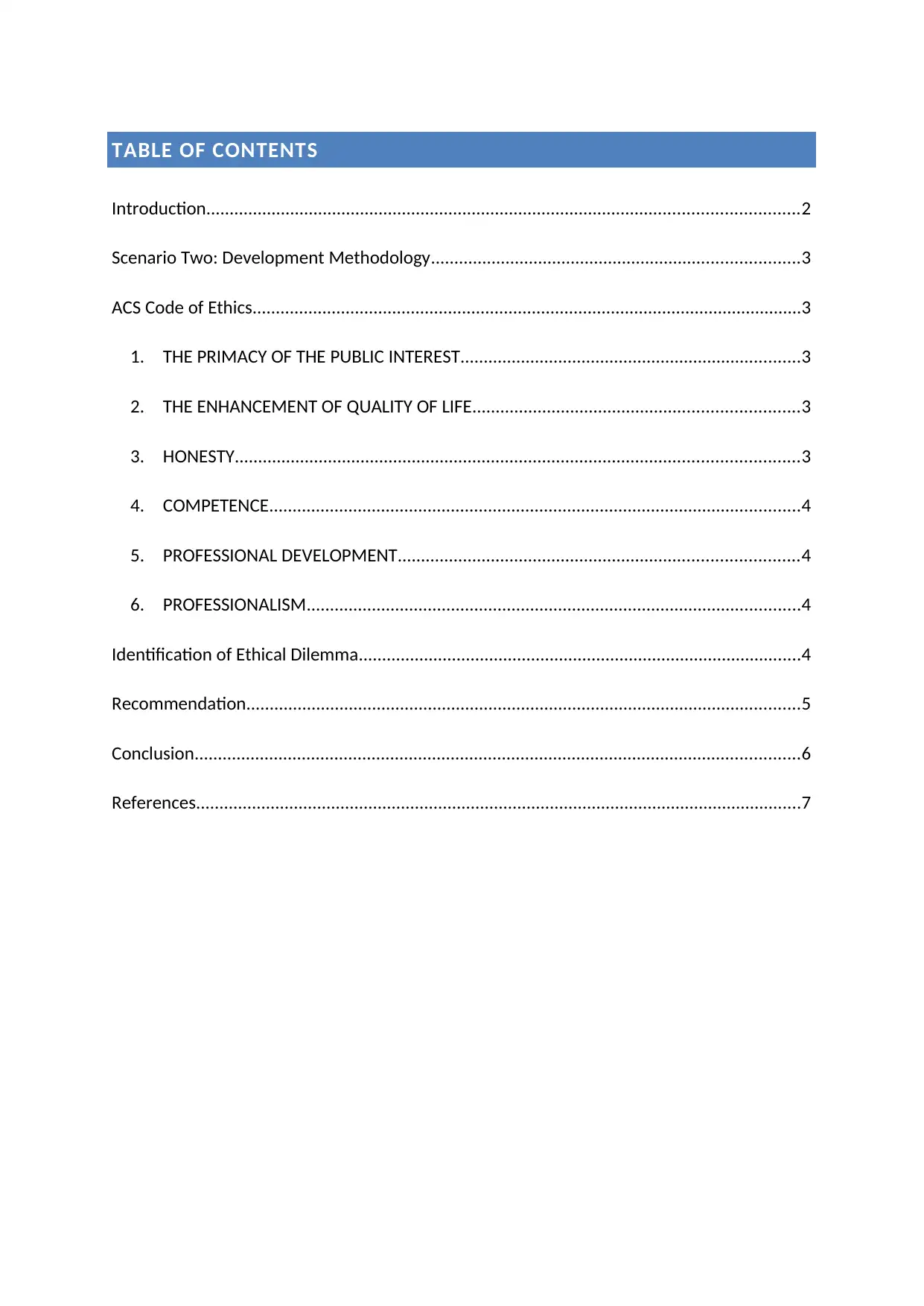
TABLE OF CONTENTS
Introduction...............................................................................................................................2
Scenario Two: Development Methodology...............................................................................3
ACS Code of Ethics......................................................................................................................3
1. THE PRIMACY OF THE PUBLIC INTEREST.........................................................................3
2. THE ENHANCEMENT OF QUALITY OF LIFE......................................................................3
3. HONESTY.........................................................................................................................3
4. COMPETENCE..................................................................................................................4
5. PROFESSIONAL DEVELOPMENT......................................................................................4
6. PROFESSIONALISM..........................................................................................................4
Identification of Ethical Dilemma...............................................................................................4
Recommendation.......................................................................................................................5
Conclusion..................................................................................................................................6
References..................................................................................................................................7
Introduction...............................................................................................................................2
Scenario Two: Development Methodology...............................................................................3
ACS Code of Ethics......................................................................................................................3
1. THE PRIMACY OF THE PUBLIC INTEREST.........................................................................3
2. THE ENHANCEMENT OF QUALITY OF LIFE......................................................................3
3. HONESTY.........................................................................................................................3
4. COMPETENCE..................................................................................................................4
5. PROFESSIONAL DEVELOPMENT......................................................................................4
6. PROFESSIONALISM..........................................................................................................4
Identification of Ethical Dilemma...............................................................................................4
Recommendation.......................................................................................................................5
Conclusion..................................................................................................................................6
References..................................................................................................................................7
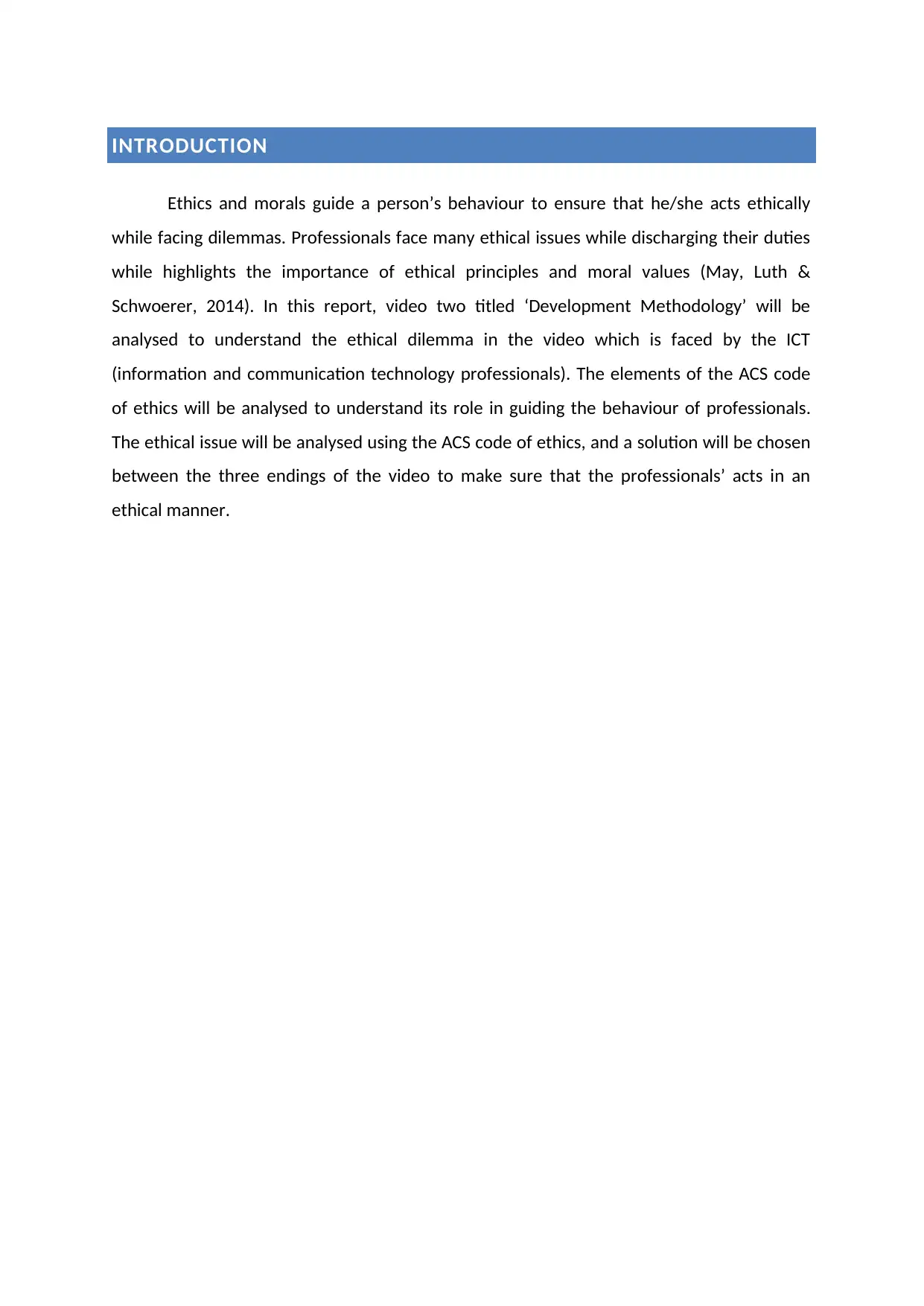
INTRODUCTION
Ethics and morals guide a person’s behaviour to ensure that he/she acts ethically
while facing dilemmas. Professionals face many ethical issues while discharging their duties
while highlights the importance of ethical principles and moral values (May, Luth &
Schwoerer, 2014). In this report, video two titled ‘Development Methodology’ will be
analysed to understand the ethical dilemma in the video which is faced by the ICT
(information and communication technology professionals). The elements of the ACS code
of ethics will be analysed to understand its role in guiding the behaviour of professionals.
The ethical issue will be analysed using the ACS code of ethics, and a solution will be chosen
between the three endings of the video to make sure that the professionals’ acts in an
ethical manner.
Ethics and morals guide a person’s behaviour to ensure that he/she acts ethically
while facing dilemmas. Professionals face many ethical issues while discharging their duties
while highlights the importance of ethical principles and moral values (May, Luth &
Schwoerer, 2014). In this report, video two titled ‘Development Methodology’ will be
analysed to understand the ethical dilemma in the video which is faced by the ICT
(information and communication technology professionals). The elements of the ACS code
of ethics will be analysed to understand its role in guiding the behaviour of professionals.
The ethical issue will be analysed using the ACS code of ethics, and a solution will be chosen
between the three endings of the video to make sure that the professionals’ acts in an
ethical manner.
⊘ This is a preview!⊘
Do you want full access?
Subscribe today to unlock all pages.

Trusted by 1+ million students worldwide

SCENARIO TWO: DEVELOPMENT METHODOLOGY
The video shows a junior developer receiving a call from the client who asks him to
make specific in the software (Al-Saggaf, 2016). During the call, the junior developer
confirms these changes to the client by stating that they will be included in the final
software at the time of delivery. The junior developer did not confirm with the project
manager regarding whether these changes are appropriate or not and whether the
company will be able to make them without exceeding the given deadline and budget. This
resulted in overriding of position hierarchy since the junior developer directly deals with the
client rather than first discussing with the project manager (Al-Saggaf, 2016).
ACS CODE OF ETHICS
The Australian Computer Society (ACS) has provided various principles with an
objective to guide professionals through ethical dilemmas to make sure that they take
ethical decisions while taking challenges in their profession (ACS, 2014). These codes of
ethics ensure that professionals are not violating their duties and they promote the integrity
and respect of ACS and its members.
1. THE PRIMACY OF THE PUBLIC INTEREST
As a professional, ACS member must ensure that the best interest of the public is put
forward rather than the personal, business and sectional interest of the professional.
2. THE ENHANCEMENT OF QUALITY OF LIFE
As an ACS member, professionals should take appropriate steps to promote the quality
of life of those affected by their work.
3. HONESTY
Without honesty in the work of professionals, the trust of the public cannot be
maintained in the profession; thus, members should maintain honesty during their work.
The video shows a junior developer receiving a call from the client who asks him to
make specific in the software (Al-Saggaf, 2016). During the call, the junior developer
confirms these changes to the client by stating that they will be included in the final
software at the time of delivery. The junior developer did not confirm with the project
manager regarding whether these changes are appropriate or not and whether the
company will be able to make them without exceeding the given deadline and budget. This
resulted in overriding of position hierarchy since the junior developer directly deals with the
client rather than first discussing with the project manager (Al-Saggaf, 2016).
ACS CODE OF ETHICS
The Australian Computer Society (ACS) has provided various principles with an
objective to guide professionals through ethical dilemmas to make sure that they take
ethical decisions while taking challenges in their profession (ACS, 2014). These codes of
ethics ensure that professionals are not violating their duties and they promote the integrity
and respect of ACS and its members.
1. THE PRIMACY OF THE PUBLIC INTEREST
As a professional, ACS member must ensure that the best interest of the public is put
forward rather than the personal, business and sectional interest of the professional.
2. THE ENHANCEMENT OF QUALITY OF LIFE
As an ACS member, professionals should take appropriate steps to promote the quality
of life of those affected by their work.
3. HONESTY
Without honesty in the work of professionals, the trust of the public cannot be
maintained in the profession; thus, members should maintain honesty during their work.
Paraphrase This Document
Need a fresh take? Get an instant paraphrase of this document with our AI Paraphraser

4. COMPETENCE
Competency and diligence in work is a key duty of ICT professionals to ensure that they
maintain the interest of their stakeholders.
5. PROFESSIONAL DEVELOPMENT
As an ICT professional, it is important that members engage in practices for personal
development along with the development of their staff members.
6. PROFESSIONALISM
Maintenance of integrity in the ACS and the respect for its members in public is
necessary which can be achieved when ICT professionals discharge their duties in a
professional manner.
IDENTIFICATION OF ETHICAL DILEMMA
The ethical dilemma presented in the video is caused because the ICT professionals
did not comply with the ACS code of ethics. The junior developer directly dealt with the
client through the phone and agreed to the changes requested by the client. This phone call
laid the foundation for the ethical dilemma because the junior developer did not follow the
position hierarchy in the organisation (Zuppo, 2012). He overrides such hierarchy by not
taking the approval of the project manager before agreeing to the changes in the software.
This shows a violation of the ACS code of ethics because the developer was not honest. He
did not have the authority or the position to agree to those changes which shows that he
was not honest.
The developer also did not act in a professional manner by failing to comply with the
position hierarchy in the workplace. The changes in the software can increase its
vulnerability towards cyber-attacks or exceed the set budget by the company which could
adversely affect the quality of the software (Ross, Barr & Stevens, 2013). It leads to
increasing the vulnerability of the data of users of this software which shows that the junior
Competency and diligence in work is a key duty of ICT professionals to ensure that they
maintain the interest of their stakeholders.
5. PROFESSIONAL DEVELOPMENT
As an ICT professional, it is important that members engage in practices for personal
development along with the development of their staff members.
6. PROFESSIONALISM
Maintenance of integrity in the ACS and the respect for its members in public is
necessary which can be achieved when ICT professionals discharge their duties in a
professional manner.
IDENTIFICATION OF ETHICAL DILEMMA
The ethical dilemma presented in the video is caused because the ICT professionals
did not comply with the ACS code of ethics. The junior developer directly dealt with the
client through the phone and agreed to the changes requested by the client. This phone call
laid the foundation for the ethical dilemma because the junior developer did not follow the
position hierarchy in the organisation (Zuppo, 2012). He overrides such hierarchy by not
taking the approval of the project manager before agreeing to the changes in the software.
This shows a violation of the ACS code of ethics because the developer was not honest. He
did not have the authority or the position to agree to those changes which shows that he
was not honest.
The developer also did not act in a professional manner by failing to comply with the
position hierarchy in the workplace. The changes in the software can increase its
vulnerability towards cyber-attacks or exceed the set budget by the company which could
adversely affect the quality of the software (Ross, Barr & Stevens, 2013). It leads to
increasing the vulnerability of the data of users of this software which shows that the junior
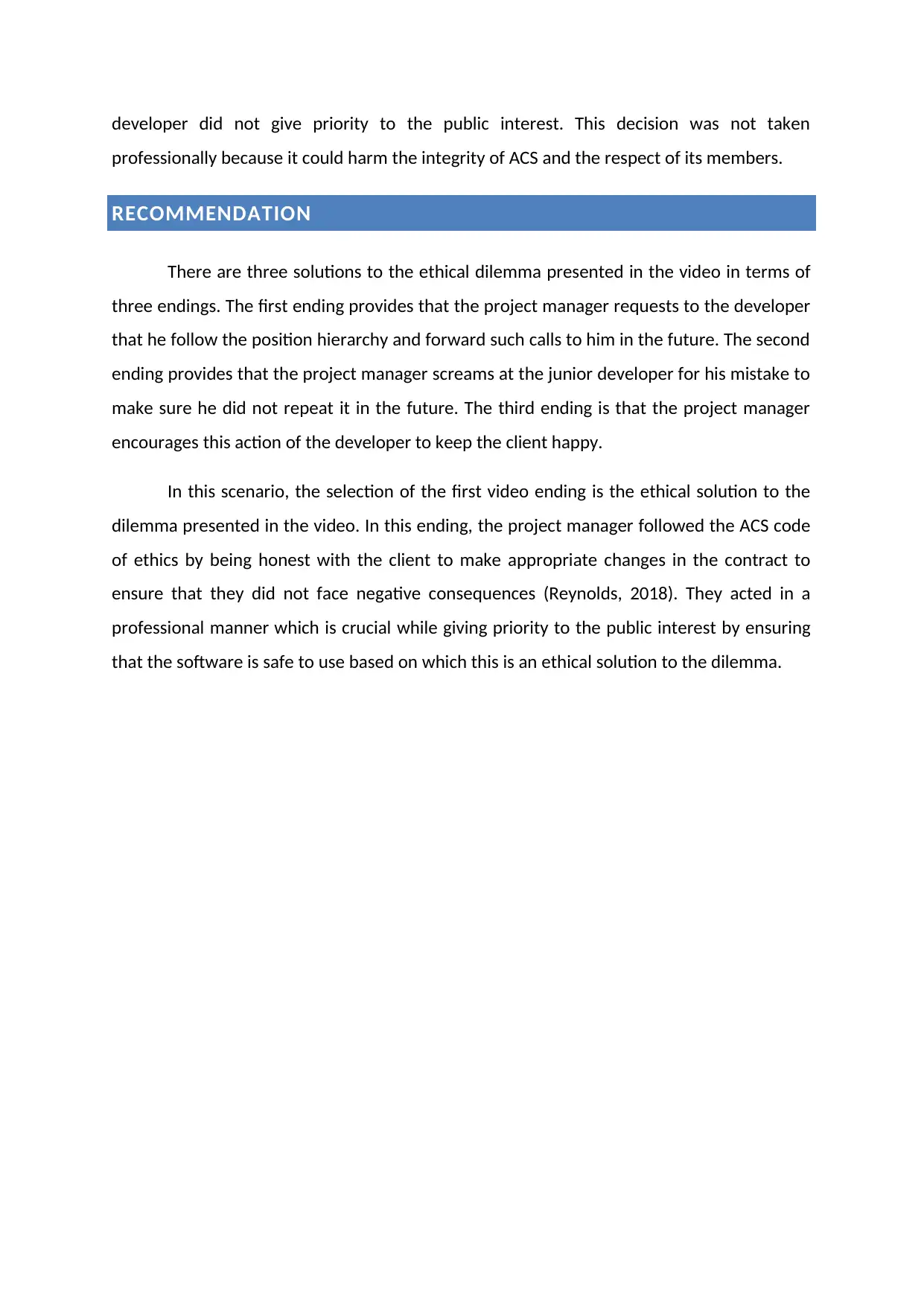
developer did not give priority to the public interest. This decision was not taken
professionally because it could harm the integrity of ACS and the respect of its members.
RECOMMENDATION
There are three solutions to the ethical dilemma presented in the video in terms of
three endings. The first ending provides that the project manager requests to the developer
that he follow the position hierarchy and forward such calls to him in the future. The second
ending provides that the project manager screams at the junior developer for his mistake to
make sure he did not repeat it in the future. The third ending is that the project manager
encourages this action of the developer to keep the client happy.
In this scenario, the selection of the first video ending is the ethical solution to the
dilemma presented in the video. In this ending, the project manager followed the ACS code
of ethics by being honest with the client to make appropriate changes in the contract to
ensure that they did not face negative consequences (Reynolds, 2018). They acted in a
professional manner which is crucial while giving priority to the public interest by ensuring
that the software is safe to use based on which this is an ethical solution to the dilemma.
professionally because it could harm the integrity of ACS and the respect of its members.
RECOMMENDATION
There are three solutions to the ethical dilemma presented in the video in terms of
three endings. The first ending provides that the project manager requests to the developer
that he follow the position hierarchy and forward such calls to him in the future. The second
ending provides that the project manager screams at the junior developer for his mistake to
make sure he did not repeat it in the future. The third ending is that the project manager
encourages this action of the developer to keep the client happy.
In this scenario, the selection of the first video ending is the ethical solution to the
dilemma presented in the video. In this ending, the project manager followed the ACS code
of ethics by being honest with the client to make appropriate changes in the contract to
ensure that they did not face negative consequences (Reynolds, 2018). They acted in a
professional manner which is crucial while giving priority to the public interest by ensuring
that the software is safe to use based on which this is an ethical solution to the dilemma.
⊘ This is a preview!⊘
Do you want full access?
Subscribe today to unlock all pages.

Trusted by 1+ million students worldwide
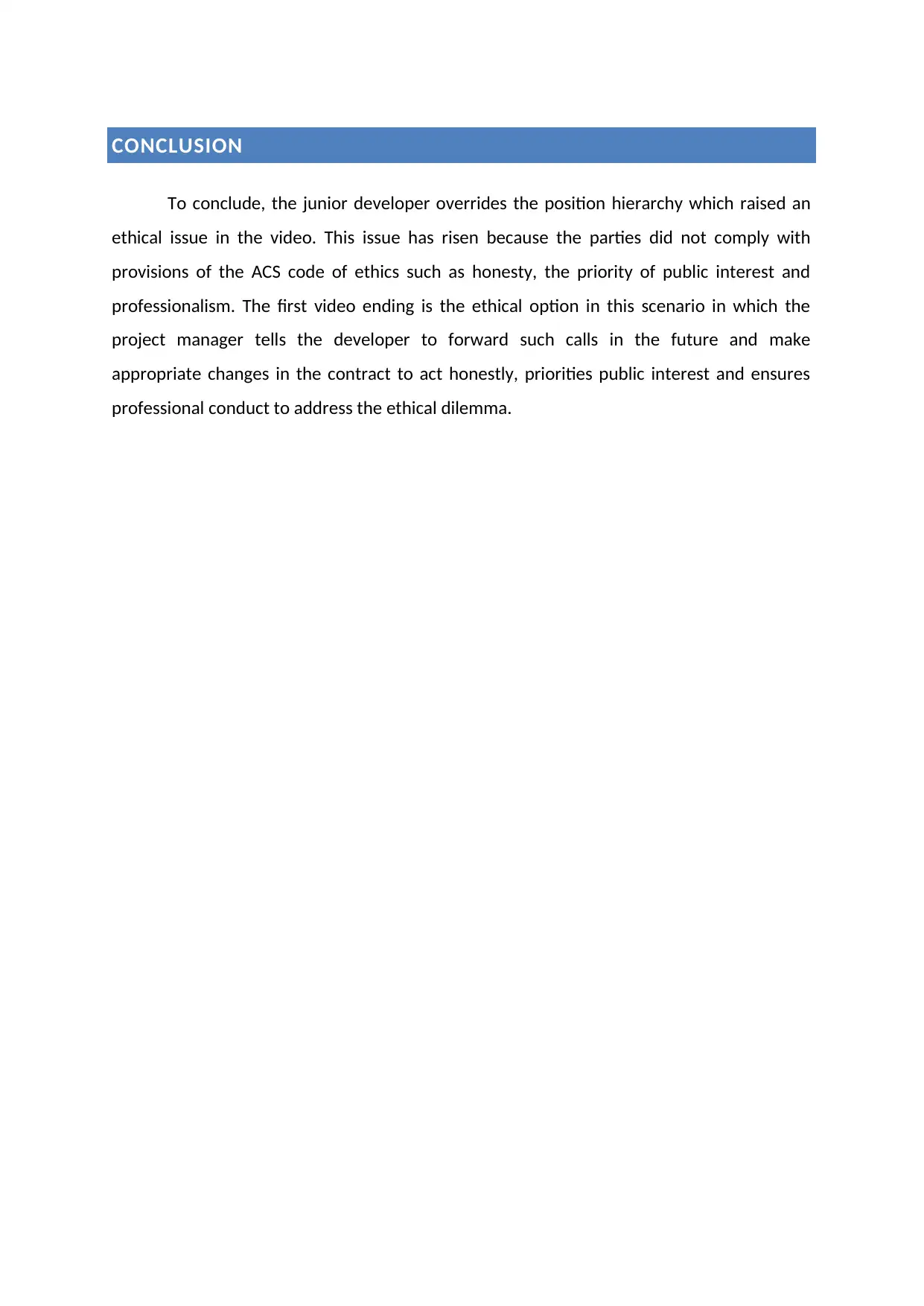
CONCLUSION
To conclude, the junior developer overrides the position hierarchy which raised an
ethical issue in the video. This issue has risen because the parties did not comply with
provisions of the ACS code of ethics such as honesty, the priority of public interest and
professionalism. The first video ending is the ethical option in this scenario in which the
project manager tells the developer to forward such calls in the future and make
appropriate changes in the contract to act honestly, priorities public interest and ensures
professional conduct to address the ethical dilemma.
To conclude, the junior developer overrides the position hierarchy which raised an
ethical issue in the video. This issue has risen because the parties did not comply with
provisions of the ACS code of ethics such as honesty, the priority of public interest and
professionalism. The first video ending is the ethical option in this scenario in which the
project manager tells the developer to forward such calls in the future and make
appropriate changes in the contract to act honestly, priorities public interest and ensures
professional conduct to address the ethical dilemma.
Paraphrase This Document
Need a fresh take? Get an instant paraphrase of this document with our AI Paraphraser

REFERENCES
ACS. (2014). ACS Code of Professional Conduct. Retrieved from
https://www.acs.org.au/content/dam/acs/rules-and-regulations/Code-of-
Professional-Conduct_v2.1.pdf
Al-Saggaf, Y. (2016, October 31). Scenario 2: Development Methodology. [Video File].
Retrieved from https://www.youtube.com/watch?v=0npm9cEJBWY
May, D. R., Luth, M. T., & Schwoerer, C. E. (2014). The influence of business ethics education
on moral efficacy, moral meaningfulness, and moral courage: A quasi-experimental
study. Journal of Business Ethics, 124(1), 67-80.
Reynolds, G. (2018). Ethics in Information Technology. Boston: Cengage Learning.
Ross, K., Barr, J., & Stevens, J. (2013). Mandatory continuing professional development
requirements: what does this mean for Australian nurses. BMC nursing, 12(1), 9.
Zuppo, C. M. (2012). Defining ICT in a boundaryless world: The development of a working
hierarchy. International journal of managing information technology, 4(3), 13.
ACS. (2014). ACS Code of Professional Conduct. Retrieved from
https://www.acs.org.au/content/dam/acs/rules-and-regulations/Code-of-
Professional-Conduct_v2.1.pdf
Al-Saggaf, Y. (2016, October 31). Scenario 2: Development Methodology. [Video File].
Retrieved from https://www.youtube.com/watch?v=0npm9cEJBWY
May, D. R., Luth, M. T., & Schwoerer, C. E. (2014). The influence of business ethics education
on moral efficacy, moral meaningfulness, and moral courage: A quasi-experimental
study. Journal of Business Ethics, 124(1), 67-80.
Reynolds, G. (2018). Ethics in Information Technology. Boston: Cengage Learning.
Ross, K., Barr, J., & Stevens, J. (2013). Mandatory continuing professional development
requirements: what does this mean for Australian nurses. BMC nursing, 12(1), 9.
Zuppo, C. M. (2012). Defining ICT in a boundaryless world: The development of a working
hierarchy. International journal of managing information technology, 4(3), 13.
1 out of 8
Related Documents
Your All-in-One AI-Powered Toolkit for Academic Success.
+13062052269
info@desklib.com
Available 24*7 on WhatsApp / Email
![[object Object]](/_next/static/media/star-bottom.7253800d.svg)
Unlock your academic potential
Copyright © 2020–2025 A2Z Services. All Rights Reserved. Developed and managed by ZUCOL.





